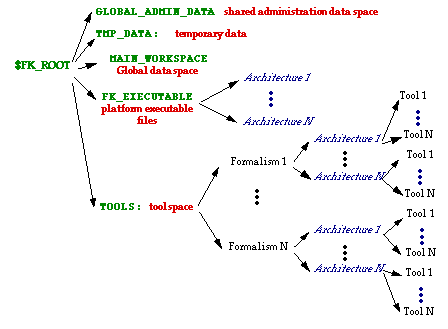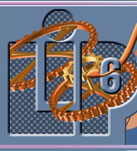Introduction
Congratulations for using FrameKit (or an environment based on FrameKit).
This page describes the installation procedure. Please follow it and do
not hesitate to report problems by means of the bug_report
procedure.
The FrameKit installation procedure relies on two types of operation:
- FrameKit directory-tree preparation: this operation has to be performed
once when you install FrameKit for the first time;
- Kit installation: this operation has to be performed for any kit you
want to install (as explained in the FrameKit
distribution strategy, there are three types of kits: platform, formalism and tool).
Warning: To be operated, FrameKit uses the installation
of TCP service 7001 nammed "framekit". If this service is not declared
in /etc/services, there is no problem, FrameKit displays a warning and
takes 7001 anyway. However, to avoid the warning, it is better to ask
your system administrator to declare this service (this operation must
be done by root).
Warning: under solaris only, you must set
in your .chsrc or .profile the LD_librARY_PATH variable in order to reach
the SunOS compatibility box required for some functions in the platform.
This library (libucb.so.1) should be located in /usr/ucblib.
Warning: If you already got FrameKit 1.3.0 and
CPN-AMI 2.0, you must proceed to new installation "from scratch". Click here for more details.
FrameKit directory-tree
preparation
First, you must create the root of the FrameKit directory-tree (in this
document, it is called FK_ROOT). You may set it in any place you
have Unix rwx access rights.
Now, you must uncompress the FrameKit installer (it is in file fk_installer.OS.V.tar
where OS is the name of the selected operating system and V
the current version of the kit). This operation must be performed in the FK_ROOT directory :
> cd $FK_ROOT
> tar xf fk_installer.OS.V.tar
Now, run the amin_kit (the FrameKit installation tool)
using the -prepare option and follow the instructions.
> admin_kit -s -prepare [lang]
Where lang indicates the required
language for this operation (-f = french, -e
= english, -s = spanish)
When this operation is completed, all the FrameKit file system is ready.
The installer should have told you the directory in which you must perform
all installations; we call it EXEC_DIR. Remember that new installations
cannot be performed from somewhere else; the admin_kit executable
file has been moved here during the preparation procedure.

Figure 1 : The FrameKit directory-tree structure.
Figure 1 shows how the FrameKit directory-tree is structured. $FK_ROOT
contains five subdirectories: GLOBAL_ADMIN_DATA is dedicated
to administration data (shared if the FrameKit runs on several workstations); TMP_DATA contains temporary FrameKit data; MAIN_WORKSPACE
is a global data storage zone for tools, FK_EXECUtable contains
FrameKit executable files and TOOLS the subtree that contains
service description for tools. Please note that in $FK_ROOT/FK_EXECUtable,
there is one distinct directoory per target architecture. So, for "architecture_i":
$EXEC_DIR=$FK_ROOT/FK_EXECUtableS/architecture_i
Notes :
- admin_kit requires gtar to uncompress kits. Please
be sure you have it in your search path.
- If you move the FrameKit directory tree after an installation, FrameKit
will not work anymore. To move the directory tree, you must reinstall
it.
Notes (for a multi-architecture installation
only):
- For those who want a multi architecture installation, cross
installation from architecture 1 to another architecture is possible.
You do not have to install the kit_installer for all architectures (however,
it is recommended).
- For those who want a multi-architecture installation (SunOS and Solaris
for example), the preparation of the file system must be done once when
you install FrameKit for the first architecture. Then, others architecture
are installed using either cross installation (at least for the first
time) or native installation. It is important if you want to share administration
data for all architectures.
Remark: for those who want a multi-architecture installation
and who have installed one installer per architecture, they have one EXEC_DIR per installed architecture.
Kit
installation
When the FrameKit file system is ready (see previous
step), you may install as many kits as you want. You must go to one
of the potential EXEC_DIR directory (there is only one if you install
FrameKit for one architecture). Then, you invoke the FrameKit installer
as follow:
> cd $EXEC_DIR
> admin_kit -s -install [-files list_of_kit_files] [lang]
The FrameKit installer will ask you where is the compressed kit to install
and will automatically perform all the installation procedure. If necessary,
it will ask you some confirmation. You may specify at least one kit by
means of the "-files" parameter. If it is not set, admin_kit will ask
you for the path of the kit to be installed (the kit list must respect
the order listed below in note ii).
Notes:
- The kit file you have imported is automatically deleted when
its installation has been performed successfuly.
- You cannot install any kit any time
but there are precedences to respect. For example, you cannot install
a tool T using formalism F without having installed the formalism. The
general order to preserve is the following:
- installation of a platform,
- installation of a formalism,
- installation of a tool for this formalism.
- The first platform kit you install must be installed under Unix (then,
read here). Then you may
continue installation from Unix or start FrameKit (then, read here)
and perform installation from the Macao user interface (using administration
tools).
Note
on the installation of FrameKit over a previous installation
Due to major changes there could be an incompatibility between the current
version of the FrameKit installer and the previous one (this is the case
betwwen 1.3.0 and 1.4.0, as well as between 1.4.1
and 1.4.2). Then, it is impossible to proceed to an upgrade of
FrameKit (and the installed tools). So, you must run to a new installation
"from scratch". This page explain you how to preserve some information
like the FrameKit users and groups list.
Important notes:
- When you install a full package, the install_me script preserve
all the administration information for you.
- You cannot upgrade some packages of CPN-AMI manually with the installer
tool because there where major changes in the menu configuration for
FrameKit. You may have big problems wy doing so.
The procedure if you want to preserve users and
groups
Groups are stored in a file called FK_groups and users in a file called
FK_users. There files are located in the directory $FK_ROOT/GLOBAL_ADMIN_DATA
where $FK_ROOT is the root directory in wich FrameKit
has been installed.
Thus, to preserve groups and users, you should do:
>cd $FK_ROOT/GLOBAL_ADMIN_DATA
>cp FK_users FK_groups SAVE_DIR
>cd $FK_ROOT
>rm -r *
proceed a new installation
>cd $FK_ROOT/GLOBAL_ADMIN_DATA
>cp SAVE_DIR/FK_users SAVE_DIR/FK_groups .
From version 1.3.0 to version 1.4.0, passwords have been encrypted in
the FK_users file. Thus, you should run admin_users in standalone mode
in order to reaffect a default password to each user. Otherwise, you will
not be able to connect using Macao.
The procedure if you want to preserve nothing
If you do not care about users and groups, you should do:
>cd $FK_ROOT/GLOBAL_ADMIN_DATA
>rm -r *
proceed a new installation
Please remind that, if you connect using Macao, the only default user
is "Administrator" with "123456" as a default password. It is advisd to
change this administration password as soon as possible.
|









